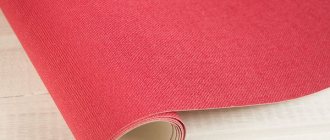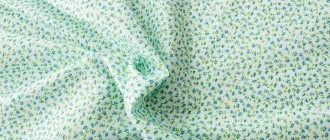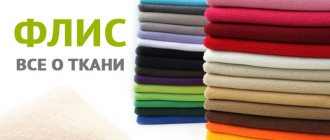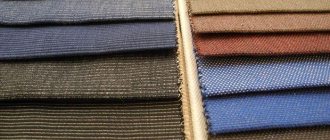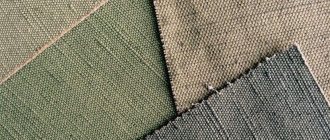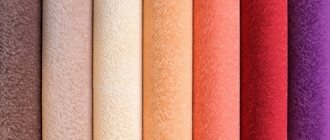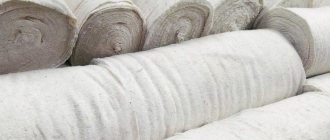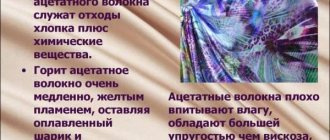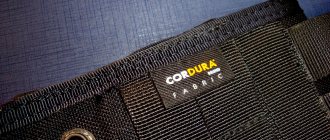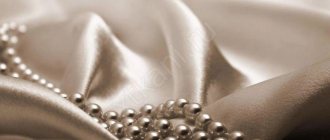Home / Synthetic fabrics
Back
Published: 01/13/2021
Reading time: 3 min
0
154
Taslan fabric is a synthetic material made using special technology. It has a special weaving structure and a waterproof reverse side. Made from nylon, it combines strength and lightness.
- 1 Description and composition
- 2 Types of material 2.1 By density
- 2.2 By type of protective impregnation
Description
The description of taslan fabric is as follows: this material is extremely light and durable. The fibers, thanks to rep weave, form a scar on the surface of the fabric that is barely visible to the eye. Because of this feature, the material rustles, so it is not suitable for hunting or fishing; it is better to buy such things for purposes where there is no need to maintain silence.
Taslan is 100% artificial material. The trick of taslan is its additional impregnation, which gives additional properties to the material.
Taslan can be of different densities, depending on the thickness of the fibers used in its manufacture.
- 185t - thin
- 228t – more dense
- 330t – the densest
Photographs of this material will help us get an idea of what kind of fabric taslan is. Let's look at the photo.
Flaws
We can speak very conditionally about the shortcomings of taslan. Its quality characteristics are not questioned and do not cause any complaints. The material has proven itself well during use. But some points with a minus sign are still worth noting:
- Popular synthetic fabric cannot be classified as a budget product, although its prices are quite affordable.
- Limited area of use. Products made from this material create a rustling noise during friction, so they are not suitable for situations where noiselessness is required - hunting, fishing.
But, despite these minor shortcomings, Taslan rightfully occupies a leading position in the ranking of the most popular synthetics today.
Note: Sometimes when working with fabric it becomes necessary to use special sewing equipment. This does not apply to all varieties, but only to those marked PU Ultra and Hi-Pora. They create slight difficulties when sewing and require certain skills.
Kinds
As we have already said, impregnation provides additional protective characteristics to taslan fabric.
What kind of membrane impregnation is applied to the canvas can be understood by looking at the markings. Let's figure out what it means if the taslan label says “milky” or “rip stop”.
- If the marking indicates Rip-Stop or R/S, it means that stronger fibers have been added to the taslan, and the material itself, accordingly, has also become stronger
- “Milky” is a white polymer layer that is applied from the reverse side. Milky ensures waterproofness of the fabric and also prevents filler fibers from penetrating the surface of the fabric
- “PU” - this layer is colorless, and therefore can be applied both from the back and from the front side. What does this give to the taslan material? This impregnation gives the fabric the properties of artificial leather and guarantees increased protection from moisture.
- "PU 3000" or higher. This taslan is considered waterproof; the numbers in this case indicate the height of the water column
- “PU foam” means that the impregnation was applied by spraying
- “WR” is a water-repellent impregnation, after application of which moisture rolls off the fabric in drops
- “Hi-Pora” is a membrane impregnation that provides the product with increased breathability.
The price per meter also depends on the impregnation and starts from 100 rubles.
Composition of popular synthetics
Taslan is made of nylon. Its official name, common in the textile industry, is NylonTaslan. Polyamide fibers can be of different thicknesses.
Please note: To increase the strength of the material, reinforcement is often used. Additional threads are woven along the warp or weft. Reinforcement in the form of cages is common. Such varieties are indicated by the Rip-Stop marking.
The peculiarity of this synthetic fabric is a polymer layer that has a porous structure. It is applied to the inside and serves as protection from cold air and precipitation. Moreover, such a coating does not prevent the removal of vapors to the outside. Neither sweat nor sebum are absorbed into the material. Thus, the pores are not clogged, which ensures their normal functioning.
About raincoat fabrics
When choosing what material a thing will be sewn from, everyone is based on their preferences. Therefore, everyone must decide for themselves what is better, taslan or, for example, a membrane. Here are the fabrics that are considered the best in this segment, and which ones can be compared with taslan:
- Taslan or cat's eye
- Duspo (read about its features at the link);
- Oxford fabric - characteristics in another article.
- Nylon (properties and benefits follow the link);
- Taslan or alova - which is better if products made from these materials are very similar in all respects.
To decide which material is right for you, we suggest reading on our website about all jacket fabrics.
Raw materials and production
Taslan is produced from polyamide fibers. When creating the fabric, rep weave of polyamide fibers is used, thanks to which the material acquires its special structure - fine ribbed.
Most often, to improve performance characteristics and give additional consumer properties, the material is impregnated with a special water-repellent composition:
- milky – waterproof composition;
- PU - artificial leather based on polyurethane, waterproof;
- WR – water-repellent composition.
Also, to enhance wear resistance and strength, taslan is often reinforced by weaving reinforcing threads in the longitudinal or transverse direction.
The density of the material can be different - from 110 to 175 grams per square meter.
Characteristics
- The material is lightweight, but at the same time very durable. Bending, friction, tension - he doesn’t care about everything
- Cutting fabric and sewing from it is quite simple
- Lets air through. There will be no greenhouse effect in things made from this material even with heavy physical exertion
- Waterproof plus water repellent. Drops of liquid will simply roll down the surface
- Maintains color brightness - does not fade in the sun
- The products are very easy to care for
- Does not absorb sweat and fat
- A huge advantage of products made from this material is the fact that under constant and fairly strong influence of aggressive external factors, taslan retains all its properties.
Coloring is the basis of external aesthetics
Taslan amazes with its brightness and colorfulness. It can be glossy or matte. The color scheme is rich in many shades and tones. Dyes penetrate deeply into the structure of polyamide fibers, becoming fixed in them. Therefore, even with intensive use, the material retains color saturation and depth. For workwear and tourist equipment, camouflage in natural shades is often used: green, brown, gray. Pastel colors are present in demi-season products - raincoats, jackets. And children's models are full of bright colors: blue, yellow, red.
Another feature: the fabric is easy to print on. Therefore, it can be decorated with various prints: floral, geometric, abstract.
Application
What are they sewing from this material? First of all, those things that are constantly exposed to external influences.
- Sports outerwear and activewear. Jackets made from this material are resistant to any weather. The addition of insulation allows these clothes to be used for winter sports, such as skiing or snowboarding. A taslan suit with many pockets is very popular. It's called "Gorka".
- Children's outerwear. In this case, Taslan will be an ideal option, because things made from it do not allow water to pass through, but at the same time breathe. They are difficult to tear, and dirt can be wiped off with an ordinary napkin.
- Durable and waterproof material is good for making bags and backpacks, as well as protective gloves and hats
- This material proved to be excellent as a covering for furniture.
Read about the new matter of Pikachu, you will be interested.
Purpose
Fabrics are used for sewing:
Author:
Zakharova Nina Afanasyevna
I hope you like my article! If you find any shortcomings, just write to me about it! I am always ready for a conversation and will answer any questions you have, ask them!
